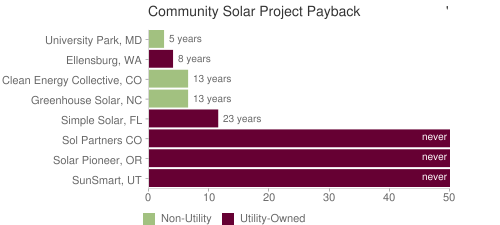Yesterday, the Interstate Renewable Energy Council (IREC) released their model program rules for community renewable energy projects [pdf].
IREC’s new model rules consider many of the basic issues facing community renewables programs. These include: renewable system size, interconnection, eligibility for participation, allocation of the benefits flowing from participation, and net metering of system production. IREC developed the model program rules for community-scale renewable systems working closely with The Vote Solar Initiative, a California-based not-for-profit working to bring solar energy into the mainstream.
The goal was to illustrate the best practices for community projects, making the experience mimic on-site ownership without cannabalizing the on-site generation of renewable power.
The model provides five basic recommendations:
- Participants should be compensated for their participation, preferably by using “virtual net metering,” where a customer’s bill is reduced by the kilowatt-hours produced by their share of the community renewable energy project.
- The energy credits to customers should be valued similar to net metering (the retail electricity rate).
- Utilities should be allowed to collect appropriate compensation for managing a community renewable energy project.
- Project ownership should be varied: direct ownership, third-party ownership and utility ownership.
- Utilities should manage community renewable energy projects.
Since our recent community solar report (Community Solar Power: Obstacles and Opportunities) provided case studies of nine operational community solar projects, I can offer a few improvements to these model rules:
- Participants’ compensation should – in real dollars – exceed their initial or ongoing investment. Community solar should be like on-site solar, where people make a reasonable return on investment, not a donation.
- Virtual net metering should mimic on-site net metering.
- Utilities should be able to cover administrative costs.
- Project ownership models should maximize the benefits to participants.
- Utilities should NOT manage community renewable energy projects unless they provide a comparable experience to non-utility projects. Of five utility-run community solar projects profiled in our community solar report, only two provided enough compensation for participants to recover their initial investment. Three of three independent community solar projects (that were not a donation model) provided a payback, and in every case it was superior to owning an on-site system.

Overall, IREC offers a good set of model rules for community renewable energy projects. However, for community solar projects utility ownership and management has led to “prepaid green pricing,” where participants pay up front for 20 years of more expensive electricity. We can do better than that.


